Project Management in Mobile App Development
VerifiedAdded on 2020/03/15
|17
|4243
|452
AI Summary
This assignment delves into the intricacies of project management specifically within the context of developing mobile applications. It examines common challenges faced during the development lifecycle, outlines effective best practices for successful execution, and explores relevant tools and methodologies used in this field. The focus is on understanding how traditional project management principles are adapted and applied to the unique demands of mobile app creation.
Contribute Materials
Your contribution can guide someone’s learning journey. Share your
documents today.
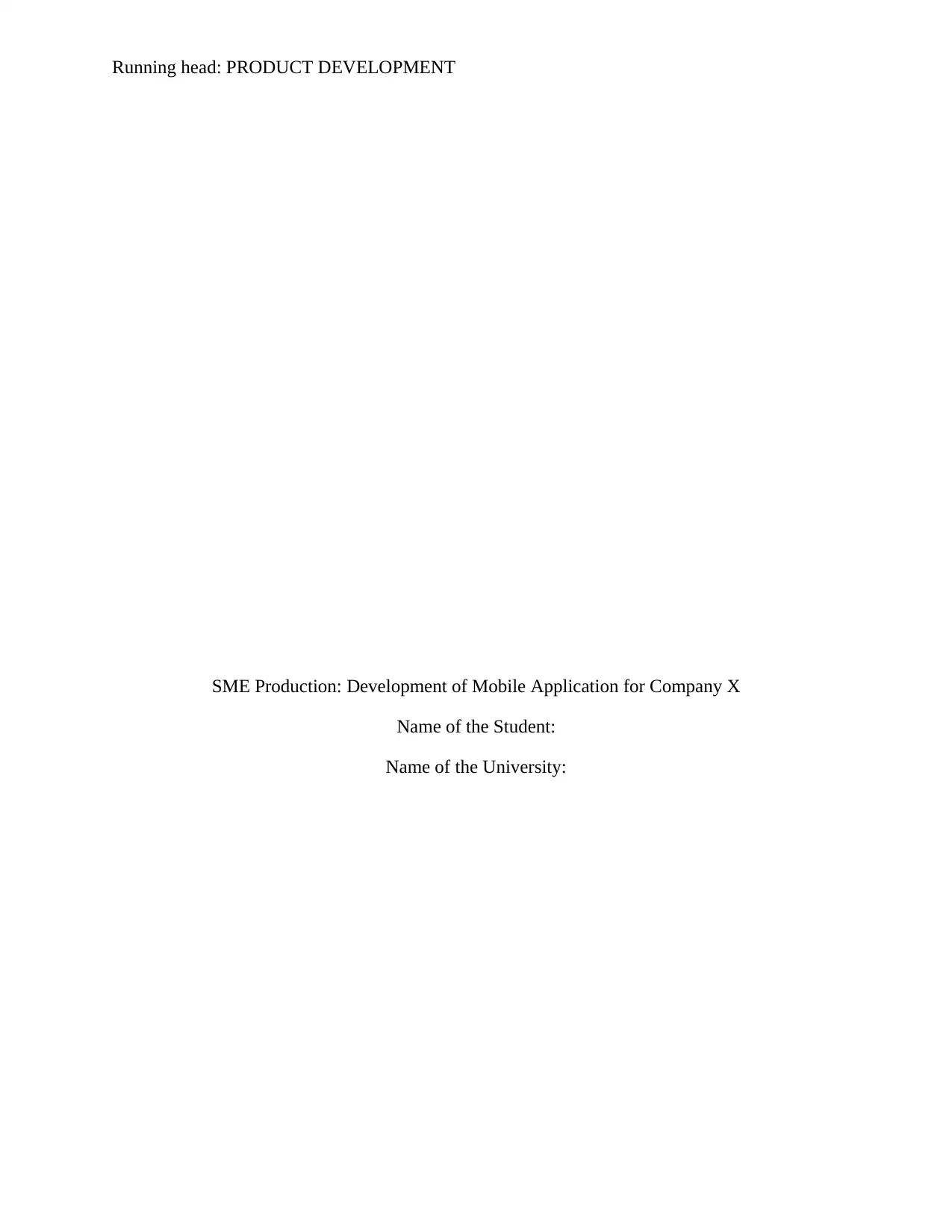
Running head: PRODUCT DEVELOPMENT
SME Production: Development of Mobile Application for Company X
Name of the Student:
Name of the University:
SME Production: Development of Mobile Application for Company X
Name of the Student:
Name of the University:
Secure Best Marks with AI Grader
Need help grading? Try our AI Grader for instant feedback on your assignments.
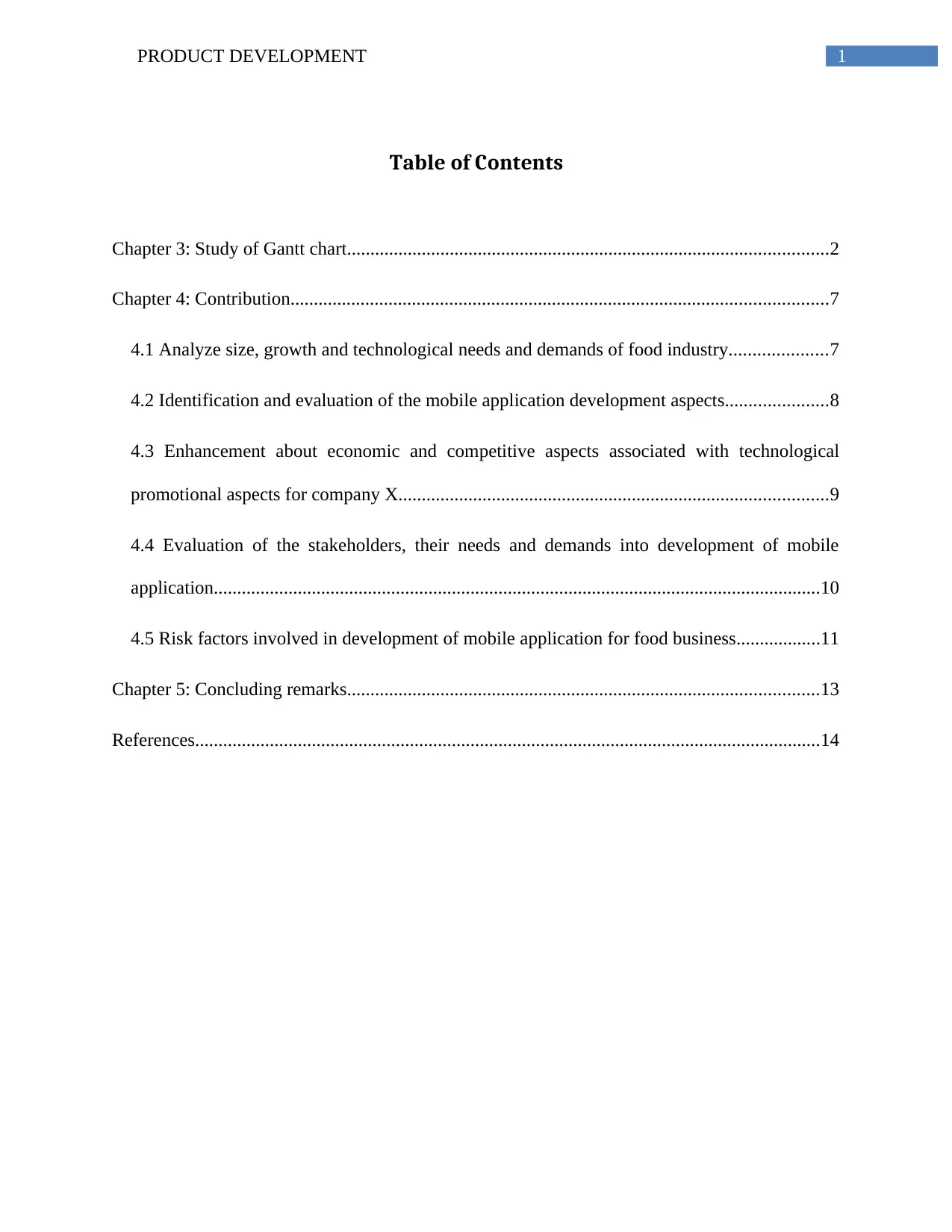
1PRODUCT DEVELOPMENT
Table of Contents
Chapter 3: Study of Gantt chart.......................................................................................................2
Chapter 4: Contribution...................................................................................................................7
4.1 Analyze size, growth and technological needs and demands of food industry.....................7
4.2 Identification and evaluation of the mobile application development aspects......................8
4.3 Enhancement about economic and competitive aspects associated with technological
promotional aspects for company X............................................................................................9
4.4 Evaluation of the stakeholders, their needs and demands into development of mobile
application..................................................................................................................................10
4.5 Risk factors involved in development of mobile application for food business..................11
Chapter 5: Concluding remarks.....................................................................................................13
References......................................................................................................................................14
Table of Contents
Chapter 3: Study of Gantt chart.......................................................................................................2
Chapter 4: Contribution...................................................................................................................7
4.1 Analyze size, growth and technological needs and demands of food industry.....................7
4.2 Identification and evaluation of the mobile application development aspects......................8
4.3 Enhancement about economic and competitive aspects associated with technological
promotional aspects for company X............................................................................................9
4.4 Evaluation of the stakeholders, their needs and demands into development of mobile
application..................................................................................................................................10
4.5 Risk factors involved in development of mobile application for food business..................11
Chapter 5: Concluding remarks.....................................................................................................13
References......................................................................................................................................14
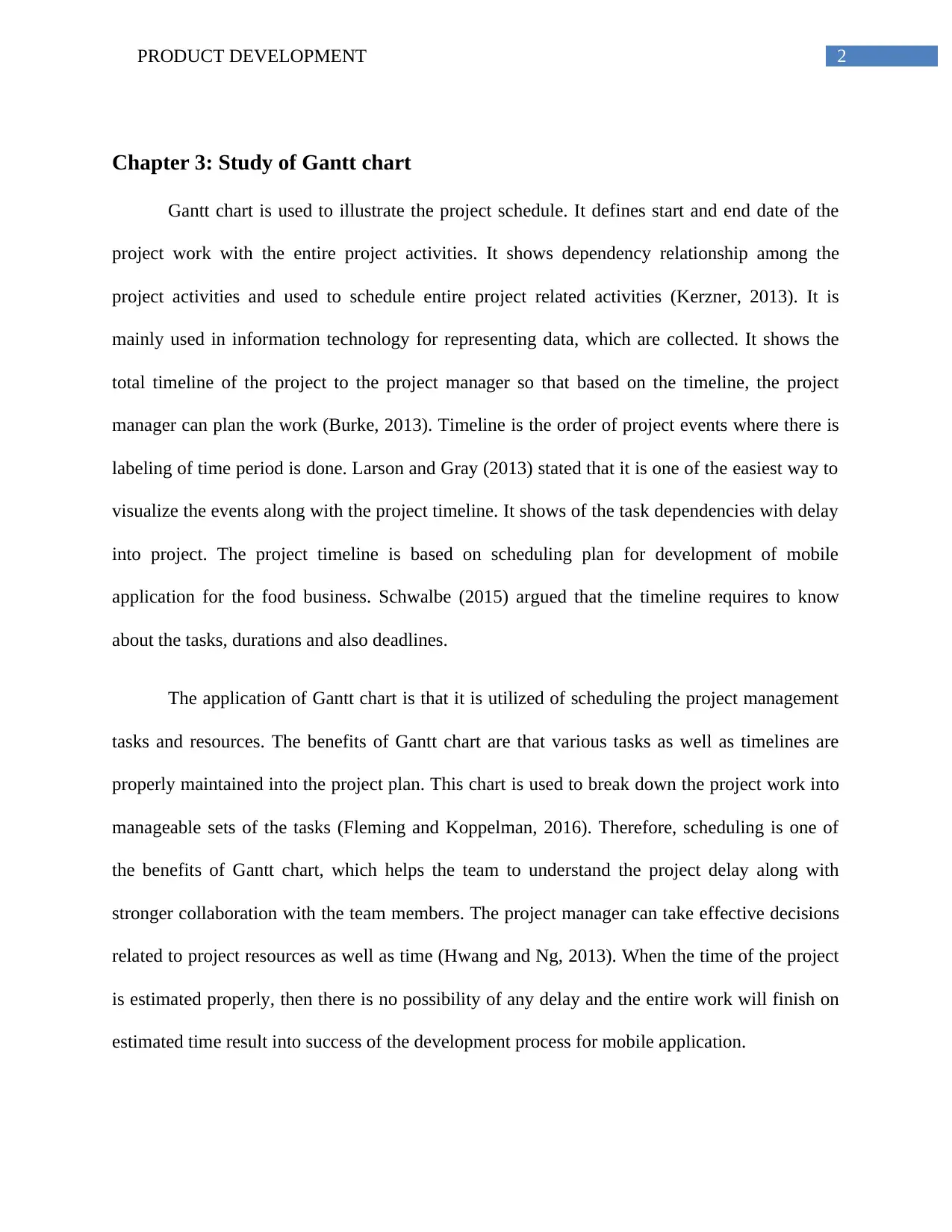
2PRODUCT DEVELOPMENT
Chapter 3: Study of Gantt chart
Gantt chart is used to illustrate the project schedule. It defines start and end date of the
project work with the entire project activities. It shows dependency relationship among the
project activities and used to schedule entire project related activities (Kerzner, 2013). It is
mainly used in information technology for representing data, which are collected. It shows the
total timeline of the project to the project manager so that based on the timeline, the project
manager can plan the work (Burke, 2013). Timeline is the order of project events where there is
labeling of time period is done. Larson and Gray (2013) stated that it is one of the easiest way to
visualize the events along with the project timeline. It shows of the task dependencies with delay
into project. The project timeline is based on scheduling plan for development of mobile
application for the food business. Schwalbe (2015) argued that the timeline requires to know
about the tasks, durations and also deadlines.
The application of Gantt chart is that it is utilized of scheduling the project management
tasks and resources. The benefits of Gantt chart are that various tasks as well as timelines are
properly maintained into the project plan. This chart is used to break down the project work into
manageable sets of the tasks (Fleming and Koppelman, 2016). Therefore, scheduling is one of
the benefits of Gantt chart, which helps the team to understand the project delay along with
stronger collaboration with the team members. The project manager can take effective decisions
related to project resources as well as time (Hwang and Ng, 2013). When the time of the project
is estimated properly, then there is no possibility of any delay and the entire work will finish on
estimated time result into success of the development process for mobile application.
Chapter 3: Study of Gantt chart
Gantt chart is used to illustrate the project schedule. It defines start and end date of the
project work with the entire project activities. It shows dependency relationship among the
project activities and used to schedule entire project related activities (Kerzner, 2013). It is
mainly used in information technology for representing data, which are collected. It shows the
total timeline of the project to the project manager so that based on the timeline, the project
manager can plan the work (Burke, 2013). Timeline is the order of project events where there is
labeling of time period is done. Larson and Gray (2013) stated that it is one of the easiest way to
visualize the events along with the project timeline. It shows of the task dependencies with delay
into project. The project timeline is based on scheduling plan for development of mobile
application for the food business. Schwalbe (2015) argued that the timeline requires to know
about the tasks, durations and also deadlines.
The application of Gantt chart is that it is utilized of scheduling the project management
tasks and resources. The benefits of Gantt chart are that various tasks as well as timelines are
properly maintained into the project plan. This chart is used to break down the project work into
manageable sets of the tasks (Fleming and Koppelman, 2016). Therefore, scheduling is one of
the benefits of Gantt chart, which helps the team to understand the project delay along with
stronger collaboration with the team members. The project manager can take effective decisions
related to project resources as well as time (Hwang and Ng, 2013). When the time of the project
is estimated properly, then there is no possibility of any delay and the entire work will finish on
estimated time result into success of the development process for mobile application.

3PRODUCT DEVELOPMENT
The entire schedule for the project is 6 months, which started with kick off meeting
among the project stakeholders. The start date of the project work is 1st November 2017 and end
date is 1st May, 2018. From the Gantt chart using Ms Project, it is seen that the project plan on
development of mobile application for food industry consists of six sub-activities. The sub-
activities with its respective duration are market analysis (23 days), stakeholder evaluation (22
days), team development (30 days), technology assessment (20 days), risk analysis and
mitigation (20 days) and final report submission (15 days). Therefore, there is total of 130 days
excluding Saturday and Sunday as non-working days. Under each of the sub-activities, there are
other activities, which are taken place to complete the development project work. Sears et al.
(2015) determined that the advantages of Gantt chart in this particular project are that it creates
picture of complexity, sets of realistic timeframe, highly visible along with concept to divide the
project activities. Before 15 days, the submission of final report activity is started.
In this development project work, Gantt chart is used as a tool for breakdown of the
project into different activities, sequence as well as indicates of the dependencies between the
project tasks (Phillips, 2013). It is used to review the completeness of the project deliverables
expected from the work. During the project life cycle, Gantt chart is used to communicate with
the project team members for performing the tasks and this particular chart determines the
progress of the plan. The main goal is that this tool is used to show provided time as well as
work schedule for the work (Hwang and Ng, 2013). Monitoring as well as controlling is easier
and it is done with least timeframe with lowest cost. The charts are being changed as well as
updated with lowest cost. The critical path into this project work analyzes the critical steps that
are completed in order to complete entire work. Therefore, it is seen that project time planning is
key significant step to meet with the project requirements. Inaccurate estimation of time is
The entire schedule for the project is 6 months, which started with kick off meeting
among the project stakeholders. The start date of the project work is 1st November 2017 and end
date is 1st May, 2018. From the Gantt chart using Ms Project, it is seen that the project plan on
development of mobile application for food industry consists of six sub-activities. The sub-
activities with its respective duration are market analysis (23 days), stakeholder evaluation (22
days), team development (30 days), technology assessment (20 days), risk analysis and
mitigation (20 days) and final report submission (15 days). Therefore, there is total of 130 days
excluding Saturday and Sunday as non-working days. Under each of the sub-activities, there are
other activities, which are taken place to complete the development project work. Sears et al.
(2015) determined that the advantages of Gantt chart in this particular project are that it creates
picture of complexity, sets of realistic timeframe, highly visible along with concept to divide the
project activities. Before 15 days, the submission of final report activity is started.
In this development project work, Gantt chart is used as a tool for breakdown of the
project into different activities, sequence as well as indicates of the dependencies between the
project tasks (Phillips, 2013). It is used to review the completeness of the project deliverables
expected from the work. During the project life cycle, Gantt chart is used to communicate with
the project team members for performing the tasks and this particular chart determines the
progress of the plan. The main goal is that this tool is used to show provided time as well as
work schedule for the work (Hwang and Ng, 2013). Monitoring as well as controlling is easier
and it is done with least timeframe with lowest cost. The charts are being changed as well as
updated with lowest cost. The critical path into this project work analyzes the critical steps that
are completed in order to complete entire work. Therefore, it is seen that project time planning is
key significant step to meet with the project requirements. Inaccurate estimation of time is
Secure Best Marks with AI Grader
Need help grading? Try our AI Grader for instant feedback on your assignments.
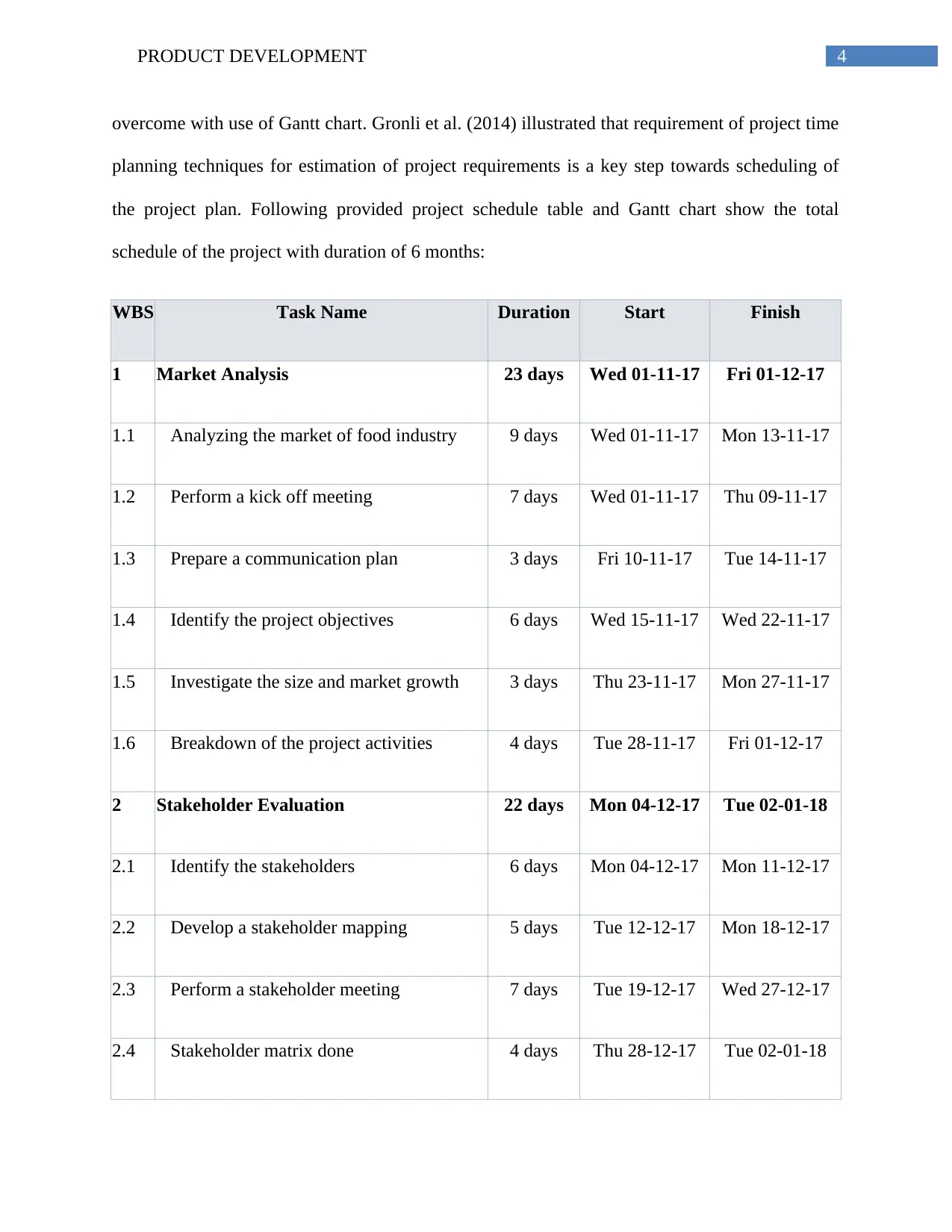
4PRODUCT DEVELOPMENT
overcome with use of Gantt chart. Gronli et al. (2014) illustrated that requirement of project time
planning techniques for estimation of project requirements is a key step towards scheduling of
the project plan. Following provided project schedule table and Gantt chart show the total
schedule of the project with duration of 6 months:
WBS Task Name Duration Start Finish
1 Market Analysis 23 days Wed 01-11-17 Fri 01-12-17
1.1 Analyzing the market of food industry 9 days Wed 01-11-17 Mon 13-11-17
1.2 Perform a kick off meeting 7 days Wed 01-11-17 Thu 09-11-17
1.3 Prepare a communication plan 3 days Fri 10-11-17 Tue 14-11-17
1.4 Identify the project objectives 6 days Wed 15-11-17 Wed 22-11-17
1.5 Investigate the size and market growth 3 days Thu 23-11-17 Mon 27-11-17
1.6 Breakdown of the project activities 4 days Tue 28-11-17 Fri 01-12-17
2 Stakeholder Evaluation 22 days Mon 04-12-17 Tue 02-01-18
2.1 Identify the stakeholders 6 days Mon 04-12-17 Mon 11-12-17
2.2 Develop a stakeholder mapping 5 days Tue 12-12-17 Mon 18-12-17
2.3 Perform a stakeholder meeting 7 days Tue 19-12-17 Wed 27-12-17
2.4 Stakeholder matrix done 4 days Thu 28-12-17 Tue 02-01-18
overcome with use of Gantt chart. Gronli et al. (2014) illustrated that requirement of project time
planning techniques for estimation of project requirements is a key step towards scheduling of
the project plan. Following provided project schedule table and Gantt chart show the total
schedule of the project with duration of 6 months:
WBS Task Name Duration Start Finish
1 Market Analysis 23 days Wed 01-11-17 Fri 01-12-17
1.1 Analyzing the market of food industry 9 days Wed 01-11-17 Mon 13-11-17
1.2 Perform a kick off meeting 7 days Wed 01-11-17 Thu 09-11-17
1.3 Prepare a communication plan 3 days Fri 10-11-17 Tue 14-11-17
1.4 Identify the project objectives 6 days Wed 15-11-17 Wed 22-11-17
1.5 Investigate the size and market growth 3 days Thu 23-11-17 Mon 27-11-17
1.6 Breakdown of the project activities 4 days Tue 28-11-17 Fri 01-12-17
2 Stakeholder Evaluation 22 days Mon 04-12-17 Tue 02-01-18
2.1 Identify the stakeholders 6 days Mon 04-12-17 Mon 11-12-17
2.2 Develop a stakeholder mapping 5 days Tue 12-12-17 Mon 18-12-17
2.3 Perform a stakeholder meeting 7 days Tue 19-12-17 Wed 27-12-17
2.4 Stakeholder matrix done 4 days Thu 28-12-17 Tue 02-01-18
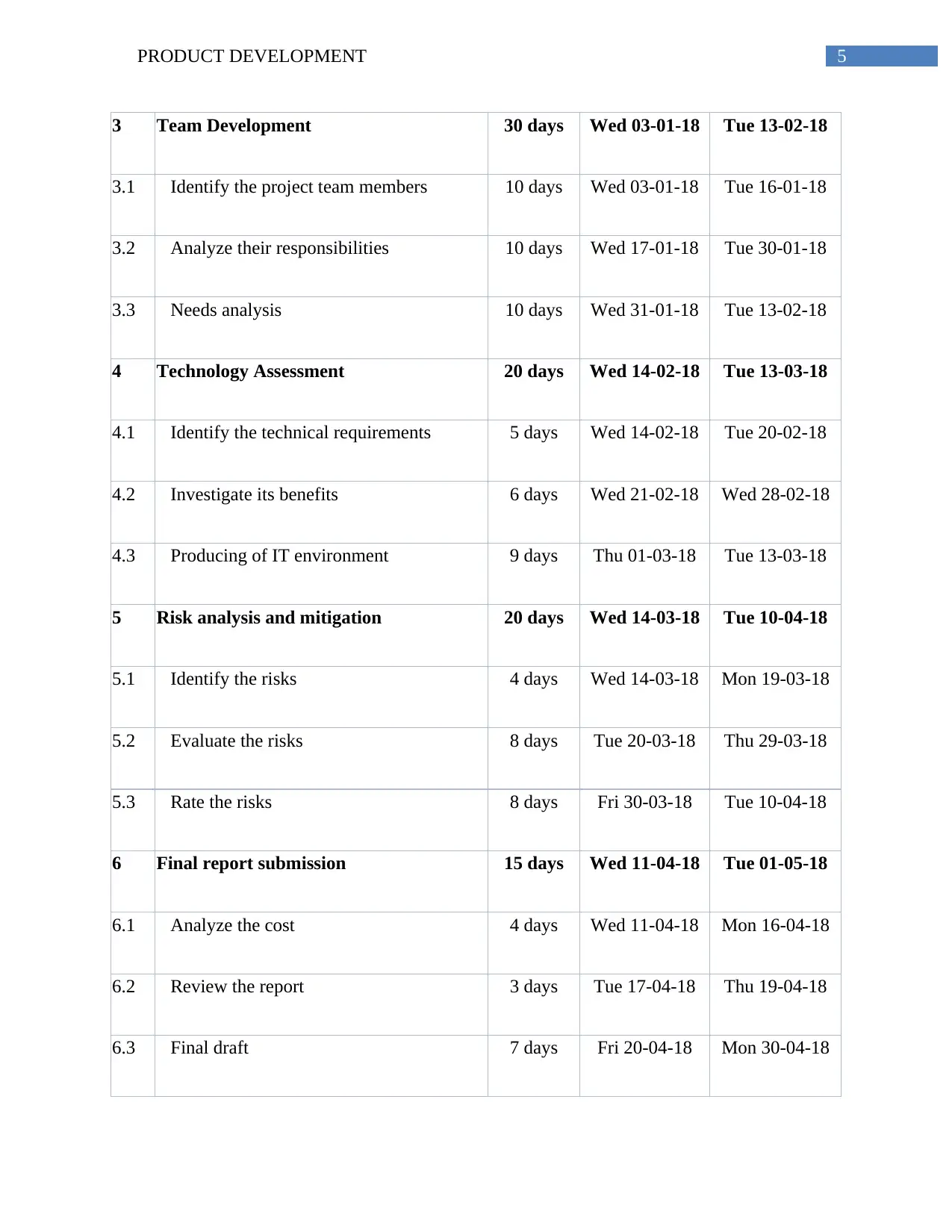
5PRODUCT DEVELOPMENT
3 Team Development 30 days Wed 03-01-18 Tue 13-02-18
3.1 Identify the project team members 10 days Wed 03-01-18 Tue 16-01-18
3.2 Analyze their responsibilities 10 days Wed 17-01-18 Tue 30-01-18
3.3 Needs analysis 10 days Wed 31-01-18 Tue 13-02-18
4 Technology Assessment 20 days Wed 14-02-18 Tue 13-03-18
4.1 Identify the technical requirements 5 days Wed 14-02-18 Tue 20-02-18
4.2 Investigate its benefits 6 days Wed 21-02-18 Wed 28-02-18
4.3 Producing of IT environment 9 days Thu 01-03-18 Tue 13-03-18
5 Risk analysis and mitigation 20 days Wed 14-03-18 Tue 10-04-18
5.1 Identify the risks 4 days Wed 14-03-18 Mon 19-03-18
5.2 Evaluate the risks 8 days Tue 20-03-18 Thu 29-03-18
5.3 Rate the risks 8 days Fri 30-03-18 Tue 10-04-18
6 Final report submission 15 days Wed 11-04-18 Tue 01-05-18
6.1 Analyze the cost 4 days Wed 11-04-18 Mon 16-04-18
6.2 Review the report 3 days Tue 17-04-18 Thu 19-04-18
6.3 Final draft 7 days Fri 20-04-18 Mon 30-04-18
3 Team Development 30 days Wed 03-01-18 Tue 13-02-18
3.1 Identify the project team members 10 days Wed 03-01-18 Tue 16-01-18
3.2 Analyze their responsibilities 10 days Wed 17-01-18 Tue 30-01-18
3.3 Needs analysis 10 days Wed 31-01-18 Tue 13-02-18
4 Technology Assessment 20 days Wed 14-02-18 Tue 13-03-18
4.1 Identify the technical requirements 5 days Wed 14-02-18 Tue 20-02-18
4.2 Investigate its benefits 6 days Wed 21-02-18 Wed 28-02-18
4.3 Producing of IT environment 9 days Thu 01-03-18 Tue 13-03-18
5 Risk analysis and mitigation 20 days Wed 14-03-18 Tue 10-04-18
5.1 Identify the risks 4 days Wed 14-03-18 Mon 19-03-18
5.2 Evaluate the risks 8 days Tue 20-03-18 Thu 29-03-18
5.3 Rate the risks 8 days Fri 30-03-18 Tue 10-04-18
6 Final report submission 15 days Wed 11-04-18 Tue 01-05-18
6.1 Analyze the cost 4 days Wed 11-04-18 Mon 16-04-18
6.2 Review the report 3 days Tue 17-04-18 Thu 19-04-18
6.3 Final draft 7 days Fri 20-04-18 Mon 30-04-18
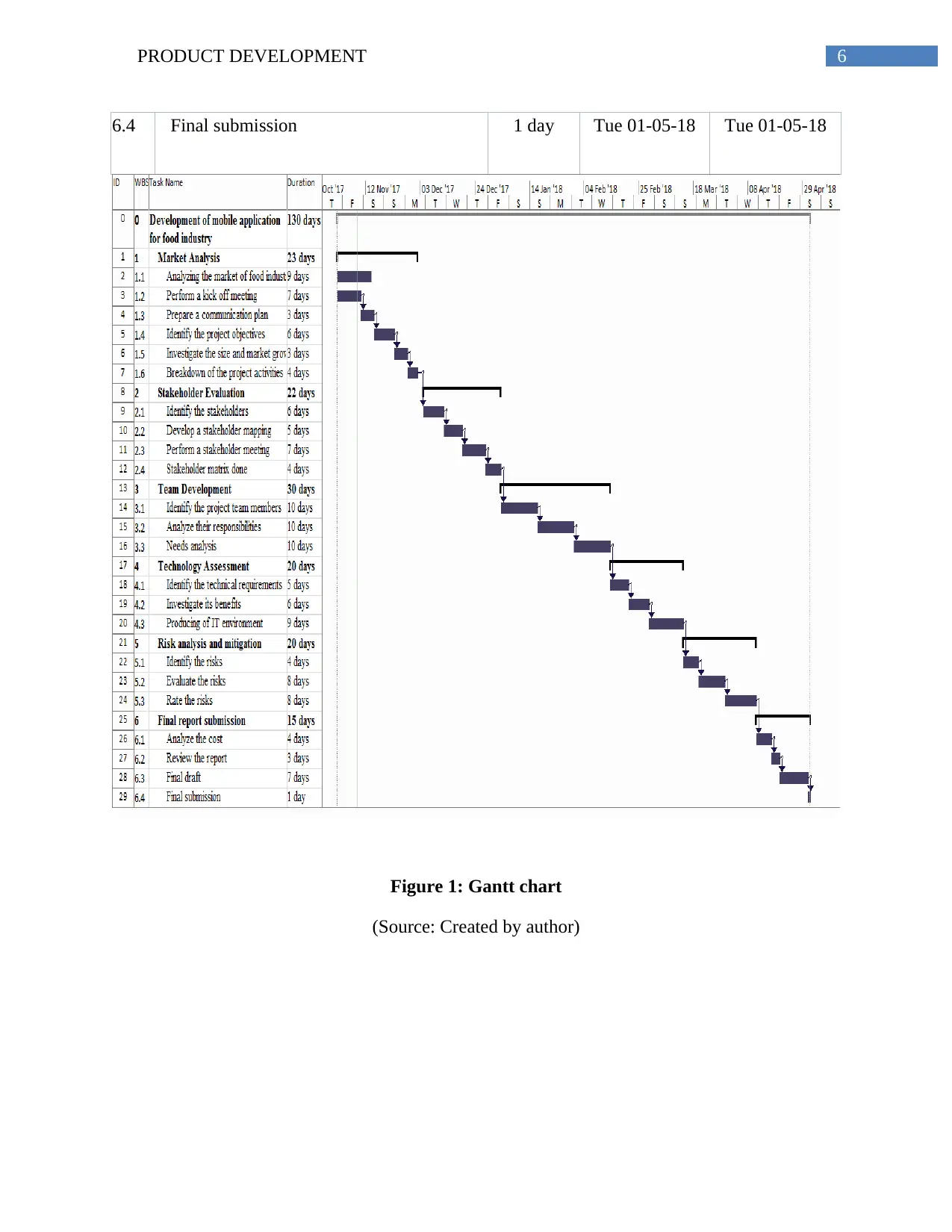
6PRODUCT DEVELOPMENT
6.4 Final submission 1 day Tue 01-05-18 Tue 01-05-18
Figure 1: Gantt chart
(Source: Created by author)
6.4 Final submission 1 day Tue 01-05-18 Tue 01-05-18
Figure 1: Gantt chart
(Source: Created by author)
Paraphrase This Document
Need a fresh take? Get an instant paraphrase of this document with our AI Paraphraser
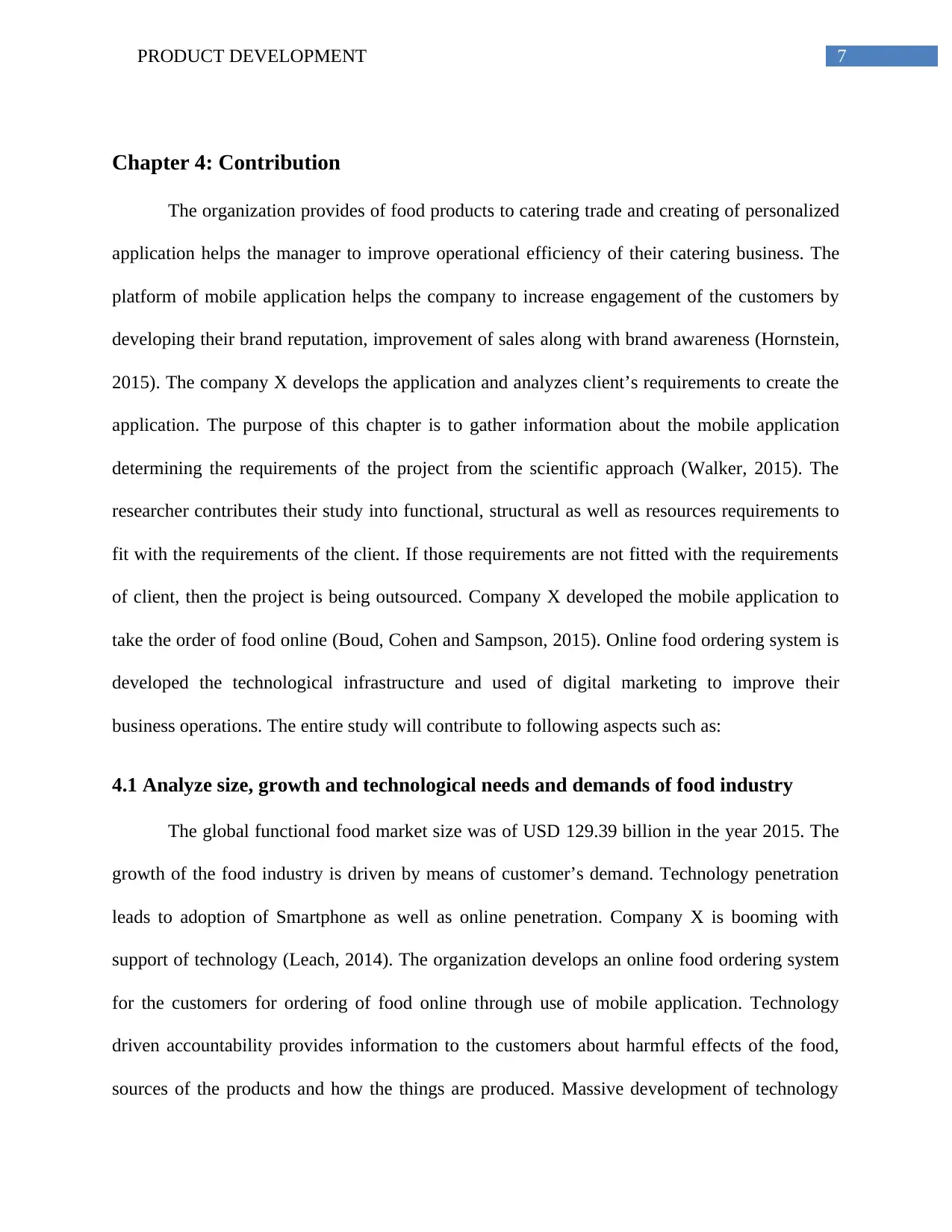
7PRODUCT DEVELOPMENT
Chapter 4: Contribution
The organization provides of food products to catering trade and creating of personalized
application helps the manager to improve operational efficiency of their catering business. The
platform of mobile application helps the company to increase engagement of the customers by
developing their brand reputation, improvement of sales along with brand awareness (Hornstein,
2015). The company X develops the application and analyzes client’s requirements to create the
application. The purpose of this chapter is to gather information about the mobile application
determining the requirements of the project from the scientific approach (Walker, 2015). The
researcher contributes their study into functional, structural as well as resources requirements to
fit with the requirements of the client. If those requirements are not fitted with the requirements
of client, then the project is being outsourced. Company X developed the mobile application to
take the order of food online (Boud, Cohen and Sampson, 2015). Online food ordering system is
developed the technological infrastructure and used of digital marketing to improve their
business operations. The entire study will contribute to following aspects such as:
4.1 Analyze size, growth and technological needs and demands of food industry
The global functional food market size was of USD 129.39 billion in the year 2015. The
growth of the food industry is driven by means of customer’s demand. Technology penetration
leads to adoption of Smartphone as well as online penetration. Company X is booming with
support of technology (Leach, 2014). The organization develops an online food ordering system
for the customers for ordering of food online through use of mobile application. Technology
driven accountability provides information to the customers about harmful effects of the food,
sources of the products and how the things are produced. Massive development of technology
Chapter 4: Contribution
The organization provides of food products to catering trade and creating of personalized
application helps the manager to improve operational efficiency of their catering business. The
platform of mobile application helps the company to increase engagement of the customers by
developing their brand reputation, improvement of sales along with brand awareness (Hornstein,
2015). The company X develops the application and analyzes client’s requirements to create the
application. The purpose of this chapter is to gather information about the mobile application
determining the requirements of the project from the scientific approach (Walker, 2015). The
researcher contributes their study into functional, structural as well as resources requirements to
fit with the requirements of the client. If those requirements are not fitted with the requirements
of client, then the project is being outsourced. Company X developed the mobile application to
take the order of food online (Boud, Cohen and Sampson, 2015). Online food ordering system is
developed the technological infrastructure and used of digital marketing to improve their
business operations. The entire study will contribute to following aspects such as:
4.1 Analyze size, growth and technological needs and demands of food industry
The global functional food market size was of USD 129.39 billion in the year 2015. The
growth of the food industry is driven by means of customer’s demand. Technology penetration
leads to adoption of Smartphone as well as online penetration. Company X is booming with
support of technology (Leach, 2014). The organization develops an online food ordering system
for the customers for ordering of food online through use of mobile application. Technology
driven accountability provides information to the customers about harmful effects of the food,
sources of the products and how the things are produced. Massive development of technology
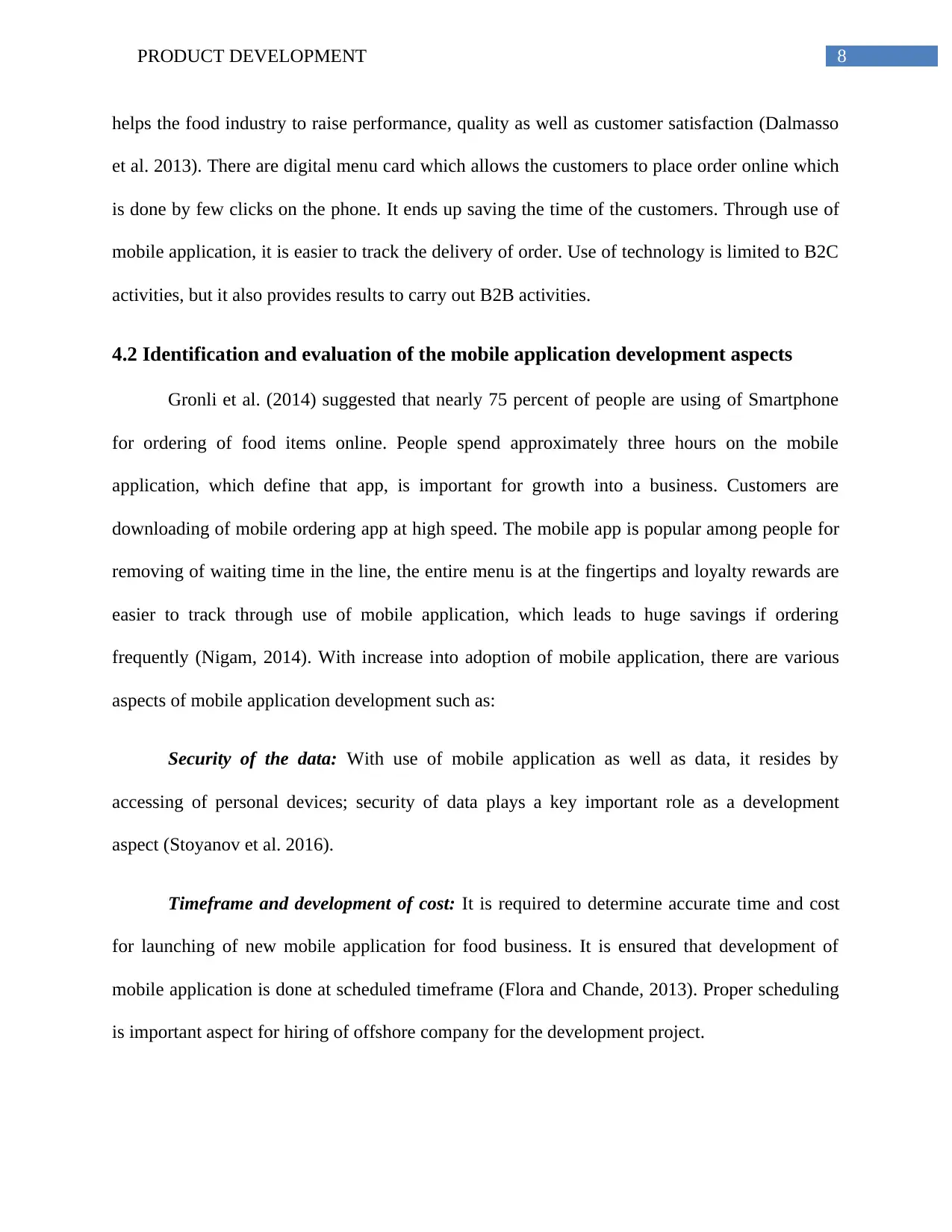
8PRODUCT DEVELOPMENT
helps the food industry to raise performance, quality as well as customer satisfaction (Dalmasso
et al. 2013). There are digital menu card which allows the customers to place order online which
is done by few clicks on the phone. It ends up saving the time of the customers. Through use of
mobile application, it is easier to track the delivery of order. Use of technology is limited to B2C
activities, but it also provides results to carry out B2B activities.
4.2 Identification and evaluation of the mobile application development aspects
Gronli et al. (2014) suggested that nearly 75 percent of people are using of Smartphone
for ordering of food items online. People spend approximately three hours on the mobile
application, which define that app, is important for growth into a business. Customers are
downloading of mobile ordering app at high speed. The mobile app is popular among people for
removing of waiting time in the line, the entire menu is at the fingertips and loyalty rewards are
easier to track through use of mobile application, which leads to huge savings if ordering
frequently (Nigam, 2014). With increase into adoption of mobile application, there are various
aspects of mobile application development such as:
Security of the data: With use of mobile application as well as data, it resides by
accessing of personal devices; security of data plays a key important role as a development
aspect (Stoyanov et al. 2016).
Timeframe and development of cost: It is required to determine accurate time and cost
for launching of new mobile application for food business. It is ensured that development of
mobile application is done at scheduled timeframe (Flora and Chande, 2013). Proper scheduling
is important aspect for hiring of offshore company for the development project.
helps the food industry to raise performance, quality as well as customer satisfaction (Dalmasso
et al. 2013). There are digital menu card which allows the customers to place order online which
is done by few clicks on the phone. It ends up saving the time of the customers. Through use of
mobile application, it is easier to track the delivery of order. Use of technology is limited to B2C
activities, but it also provides results to carry out B2B activities.
4.2 Identification and evaluation of the mobile application development aspects
Gronli et al. (2014) suggested that nearly 75 percent of people are using of Smartphone
for ordering of food items online. People spend approximately three hours on the mobile
application, which define that app, is important for growth into a business. Customers are
downloading of mobile ordering app at high speed. The mobile app is popular among people for
removing of waiting time in the line, the entire menu is at the fingertips and loyalty rewards are
easier to track through use of mobile application, which leads to huge savings if ordering
frequently (Nigam, 2014). With increase into adoption of mobile application, there are various
aspects of mobile application development such as:
Security of the data: With use of mobile application as well as data, it resides by
accessing of personal devices; security of data plays a key important role as a development
aspect (Stoyanov et al. 2016).
Timeframe and development of cost: It is required to determine accurate time and cost
for launching of new mobile application for food business. It is ensured that development of
mobile application is done at scheduled timeframe (Flora and Chande, 2013). Proper scheduling
is important aspect for hiring of offshore company for the development project.

9PRODUCT DEVELOPMENT
Selection of right platform: The mobile application is based on perfect platform for its
development. Various mobile applications are based on different platform. The application is
made with single code as well as run on various platform includes of iOS, Android (Renton et al.
2015).
Identify the target customers: The application developer should know the requirements
of end users. The success of app is based on user experience and their requirements. It is mainly
required at the time of outsourcing requirements (Vanderroost et al. 2017). It helps to create
mobile application which is user friendly along with easier to download.
4.3 Enhancement about economic and competitive aspects associated with
technological promotional aspects for company X
Economic opportunities are created as a result of adoption of mobile application includes
of employment production, gaining of business efficiency, reduction of cost, generation of
revenue, collaboration along with technological innovation into the market. Success of new
technology is based on technical efficiency (Schwalbe, 2015). It is easier to develop and innovate
of new technologies such as development of mobile application as cloud provides benefit to
scale, market speed along with adaptability. Company X adopts and develops of mobile
application into their food business for achieving a competitive advantage. It is used to increase
the brand value of the organization (Fleming and Koppelman, 2016). Due to increasing
popularity into the mobile app, it creates and anticipates of competitors going mobile. It
increases the productivity of the business organization, which helps to increase into brand
reputation of the organization. The mobile app helps the employees to stay connected into a
better way with faster mode of communication channel.
Selection of right platform: The mobile application is based on perfect platform for its
development. Various mobile applications are based on different platform. The application is
made with single code as well as run on various platform includes of iOS, Android (Renton et al.
2015).
Identify the target customers: The application developer should know the requirements
of end users. The success of app is based on user experience and their requirements. It is mainly
required at the time of outsourcing requirements (Vanderroost et al. 2017). It helps to create
mobile application which is user friendly along with easier to download.
4.3 Enhancement about economic and competitive aspects associated with
technological promotional aspects for company X
Economic opportunities are created as a result of adoption of mobile application includes
of employment production, gaining of business efficiency, reduction of cost, generation of
revenue, collaboration along with technological innovation into the market. Success of new
technology is based on technical efficiency (Schwalbe, 2015). It is easier to develop and innovate
of new technologies such as development of mobile application as cloud provides benefit to
scale, market speed along with adaptability. Company X adopts and develops of mobile
application into their food business for achieving a competitive advantage. It is used to increase
the brand value of the organization (Fleming and Koppelman, 2016). Due to increasing
popularity into the mobile app, it creates and anticipates of competitors going mobile. It
increases the productivity of the business organization, which helps to increase into brand
reputation of the organization. The mobile app helps the employees to stay connected into a
better way with faster mode of communication channel.
Secure Best Marks with AI Grader
Need help grading? Try our AI Grader for instant feedback on your assignments.
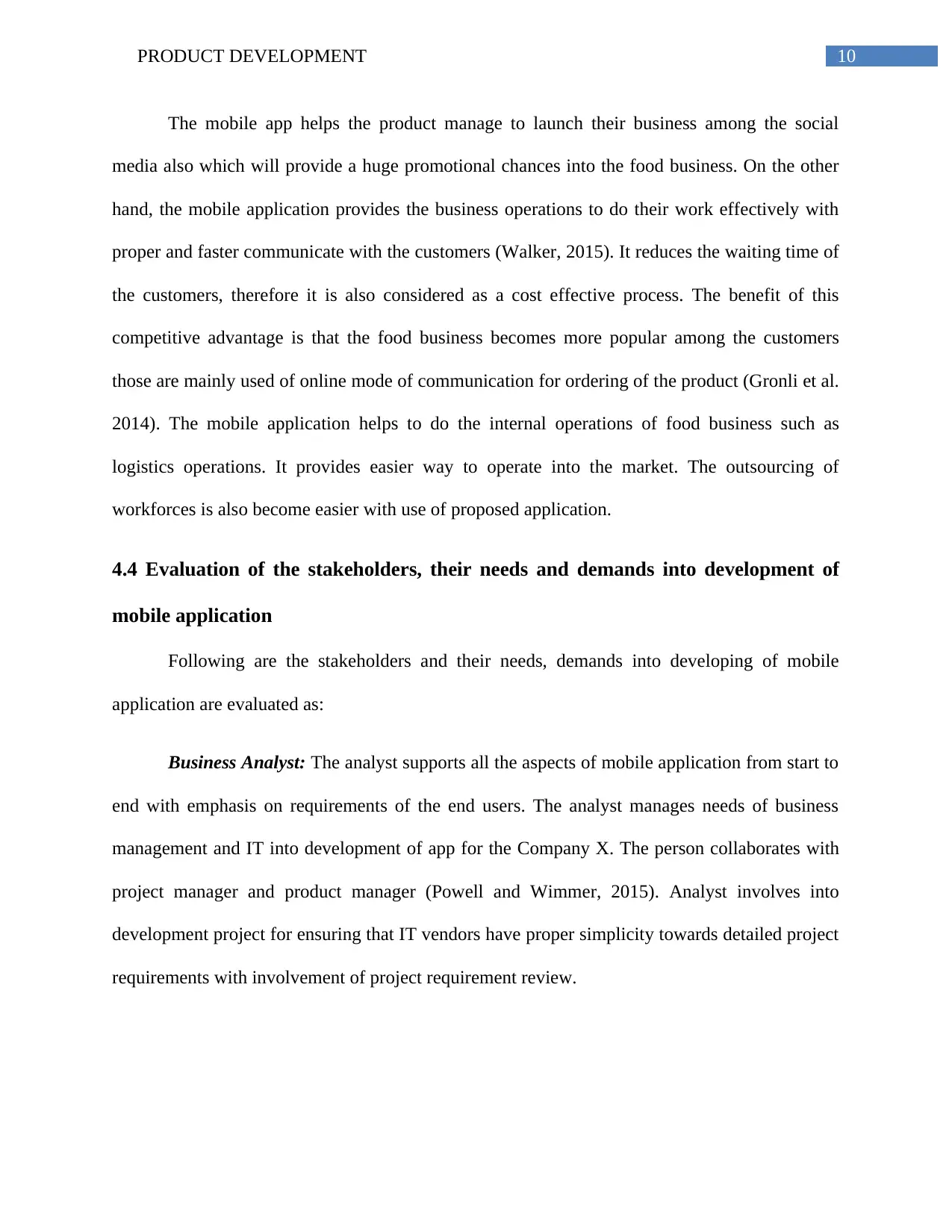
10PRODUCT DEVELOPMENT
The mobile app helps the product manage to launch their business among the social
media also which will provide a huge promotional chances into the food business. On the other
hand, the mobile application provides the business operations to do their work effectively with
proper and faster communicate with the customers (Walker, 2015). It reduces the waiting time of
the customers, therefore it is also considered as a cost effective process. The benefit of this
competitive advantage is that the food business becomes more popular among the customers
those are mainly used of online mode of communication for ordering of the product (Gronli et al.
2014). The mobile application helps to do the internal operations of food business such as
logistics operations. It provides easier way to operate into the market. The outsourcing of
workforces is also become easier with use of proposed application.
4.4 Evaluation of the stakeholders, their needs and demands into development of
mobile application
Following are the stakeholders and their needs, demands into developing of mobile
application are evaluated as:
Business Analyst: The analyst supports all the aspects of mobile application from start to
end with emphasis on requirements of the end users. The analyst manages needs of business
management and IT into development of app for the Company X. The person collaborates with
project manager and product manager (Powell and Wimmer, 2015). Analyst involves into
development project for ensuring that IT vendors have proper simplicity towards detailed project
requirements with involvement of project requirement review.
The mobile app helps the product manage to launch their business among the social
media also which will provide a huge promotional chances into the food business. On the other
hand, the mobile application provides the business operations to do their work effectively with
proper and faster communicate with the customers (Walker, 2015). It reduces the waiting time of
the customers, therefore it is also considered as a cost effective process. The benefit of this
competitive advantage is that the food business becomes more popular among the customers
those are mainly used of online mode of communication for ordering of the product (Gronli et al.
2014). The mobile application helps to do the internal operations of food business such as
logistics operations. It provides easier way to operate into the market. The outsourcing of
workforces is also become easier with use of proposed application.
4.4 Evaluation of the stakeholders, their needs and demands into development of
mobile application
Following are the stakeholders and their needs, demands into developing of mobile
application are evaluated as:
Business Analyst: The analyst supports all the aspects of mobile application from start to
end with emphasis on requirements of the end users. The analyst manages needs of business
management and IT into development of app for the Company X. The person collaborates with
project manager and product manager (Powell and Wimmer, 2015). Analyst involves into
development project for ensuring that IT vendors have proper simplicity towards detailed project
requirements with involvement of project requirement review.

11PRODUCT DEVELOPMENT
Project Manager: The manager requires t o keep budget as well as schedule of the
project on the track. They collect data and communicate with other stakeholder. They ensure that
team is meeting their goals and on track for delivery on time.
Product Manager: They are responsible for laying out of roadmap for strategic product,
supporting the product and its sales effort for the mobile application (Flora, Wang and Chande,
2014). The manager tracks the delivered product and contributes to user documentation as well
as training of the workers.
Person leading e-commerce: The e-commerce leader is interested into mobile solution
that integrates with existing platform. At time of developing of mobile strategies, the person is
responsible for improvement of mobile conversion rate and average food order value (Hwang
and Ng, 2013). The person leads the development of mobile application as it has responsibility
for success and failure of mobile e-commerce solutions.
Marketing Manager: The manager is focused on mobile strategies which deliver ROI on
the marketing investments with improvement of ordering experiences to build up brand
reputation along with loyal customers (Vanderroost et al. 2017).
IT Manager: The manager influences mobile strategies from the technical point of view.
The key considerations of the manager are to focus on speed, security and performance (Fleming
and Koppelman, 2016). The manager provides technical feasibility for each aspect of the mobile
strategies.
4.5 Risk factors involved in development of mobile application for food business
The food business is used of mobile app for taking order of food items and attracting the
customers. Following are the risk factors involved into mobile application development are:
Project Manager: The manager requires t o keep budget as well as schedule of the
project on the track. They collect data and communicate with other stakeholder. They ensure that
team is meeting their goals and on track for delivery on time.
Product Manager: They are responsible for laying out of roadmap for strategic product,
supporting the product and its sales effort for the mobile application (Flora, Wang and Chande,
2014). The manager tracks the delivered product and contributes to user documentation as well
as training of the workers.
Person leading e-commerce: The e-commerce leader is interested into mobile solution
that integrates with existing platform. At time of developing of mobile strategies, the person is
responsible for improvement of mobile conversion rate and average food order value (Hwang
and Ng, 2013). The person leads the development of mobile application as it has responsibility
for success and failure of mobile e-commerce solutions.
Marketing Manager: The manager is focused on mobile strategies which deliver ROI on
the marketing investments with improvement of ordering experiences to build up brand
reputation along with loyal customers (Vanderroost et al. 2017).
IT Manager: The manager influences mobile strategies from the technical point of view.
The key considerations of the manager are to focus on speed, security and performance (Fleming
and Koppelman, 2016). The manager provides technical feasibility for each aspect of the mobile
strategies.
4.5 Risk factors involved in development of mobile application for food business
The food business is used of mobile app for taking order of food items and attracting the
customers. Following are the risk factors involved into mobile application development are:
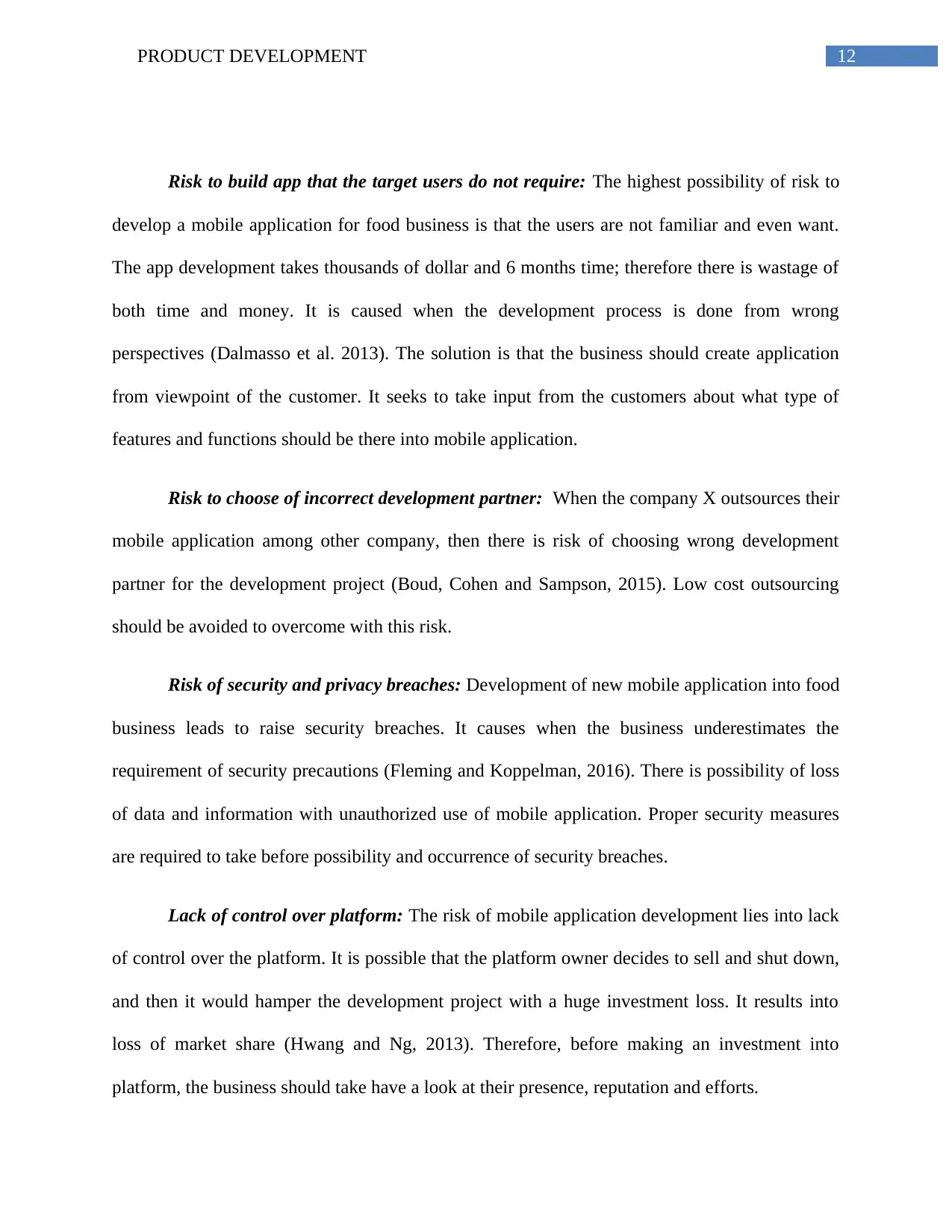
12PRODUCT DEVELOPMENT
Risk to build app that the target users do not require: The highest possibility of risk to
develop a mobile application for food business is that the users are not familiar and even want.
The app development takes thousands of dollar and 6 months time; therefore there is wastage of
both time and money. It is caused when the development process is done from wrong
perspectives (Dalmasso et al. 2013). The solution is that the business should create application
from viewpoint of the customer. It seeks to take input from the customers about what type of
features and functions should be there into mobile application.
Risk to choose of incorrect development partner: When the company X outsources their
mobile application among other company, then there is risk of choosing wrong development
partner for the development project (Boud, Cohen and Sampson, 2015). Low cost outsourcing
should be avoided to overcome with this risk.
Risk of security and privacy breaches: Development of new mobile application into food
business leads to raise security breaches. It causes when the business underestimates the
requirement of security precautions (Fleming and Koppelman, 2016). There is possibility of loss
of data and information with unauthorized use of mobile application. Proper security measures
are required to take before possibility and occurrence of security breaches.
Lack of control over platform: The risk of mobile application development lies into lack
of control over the platform. It is possible that the platform owner decides to sell and shut down,
and then it would hamper the development project with a huge investment loss. It results into
loss of market share (Hwang and Ng, 2013). Therefore, before making an investment into
platform, the business should take have a look at their presence, reputation and efforts.
Risk to build app that the target users do not require: The highest possibility of risk to
develop a mobile application for food business is that the users are not familiar and even want.
The app development takes thousands of dollar and 6 months time; therefore there is wastage of
both time and money. It is caused when the development process is done from wrong
perspectives (Dalmasso et al. 2013). The solution is that the business should create application
from viewpoint of the customer. It seeks to take input from the customers about what type of
features and functions should be there into mobile application.
Risk to choose of incorrect development partner: When the company X outsources their
mobile application among other company, then there is risk of choosing wrong development
partner for the development project (Boud, Cohen and Sampson, 2015). Low cost outsourcing
should be avoided to overcome with this risk.
Risk of security and privacy breaches: Development of new mobile application into food
business leads to raise security breaches. It causes when the business underestimates the
requirement of security precautions (Fleming and Koppelman, 2016). There is possibility of loss
of data and information with unauthorized use of mobile application. Proper security measures
are required to take before possibility and occurrence of security breaches.
Lack of control over platform: The risk of mobile application development lies into lack
of control over the platform. It is possible that the platform owner decides to sell and shut down,
and then it would hamper the development project with a huge investment loss. It results into
loss of market share (Hwang and Ng, 2013). Therefore, before making an investment into
platform, the business should take have a look at their presence, reputation and efforts.
Paraphrase This Document
Need a fresh take? Get an instant paraphrase of this document with our AI Paraphraser

13PRODUCT DEVELOPMENT
Chapter 5: Concluding remarks
It is concluded from the entire report is that development of mobile application provides
accessibility to the customers to reach company X food business. The main aim of this project is
to identify the project requirements, evaluate of both deliverables as well as project milestones
and evaluate the risk factors involved with the development process. Three requirements are
analyzed such as functional, structural and resource. Functional requirement of the app creates
convenience with the customers. This app keeps update to the customers regarding new offers
and rates. The structural requirements consist of searching for app developer, launching of the
app and its proper maintenance. It consists of implementation of app development. The resource
requirements of the mobile application are icons of supported size like iOS @1x, @2x images
and Android. Gantt chart is used to determine the start and end date of the development of
mobile application. Project planning is done through use of Gantt chart which helps in ensuring
that effective development of mobile application for company X is evaluated properly and on
scheduled time.
This particular study is focused on development of effective mobile application for
growth of company X into competitive market. Market evaluation techniques are applied along
with analysing needs and demands of the stakeholder. The entire study is contributed to
stakeholder need, risk analysis, time management and analysing technological needs of the
mobile app. The development of an online food ordering system for the customers is used to put
order of the food with utilization of mobile application. Advancement of the technology provides
all the information related to the product to the customers so that before ordering the food item,
they can get all data on particular product. The app is used into food business for increasing
customer engagement, reputation of the business’s brand along with sales improvement.
Chapter 5: Concluding remarks
It is concluded from the entire report is that development of mobile application provides
accessibility to the customers to reach company X food business. The main aim of this project is
to identify the project requirements, evaluate of both deliverables as well as project milestones
and evaluate the risk factors involved with the development process. Three requirements are
analyzed such as functional, structural and resource. Functional requirement of the app creates
convenience with the customers. This app keeps update to the customers regarding new offers
and rates. The structural requirements consist of searching for app developer, launching of the
app and its proper maintenance. It consists of implementation of app development. The resource
requirements of the mobile application are icons of supported size like iOS @1x, @2x images
and Android. Gantt chart is used to determine the start and end date of the development of
mobile application. Project planning is done through use of Gantt chart which helps in ensuring
that effective development of mobile application for company X is evaluated properly and on
scheduled time.
This particular study is focused on development of effective mobile application for
growth of company X into competitive market. Market evaluation techniques are applied along
with analysing needs and demands of the stakeholder. The entire study is contributed to
stakeholder need, risk analysis, time management and analysing technological needs of the
mobile app. The development of an online food ordering system for the customers is used to put
order of the food with utilization of mobile application. Advancement of the technology provides
all the information related to the product to the customers so that before ordering the food item,
they can get all data on particular product. The app is used into food business for increasing
customer engagement, reputation of the business’s brand along with sales improvement.
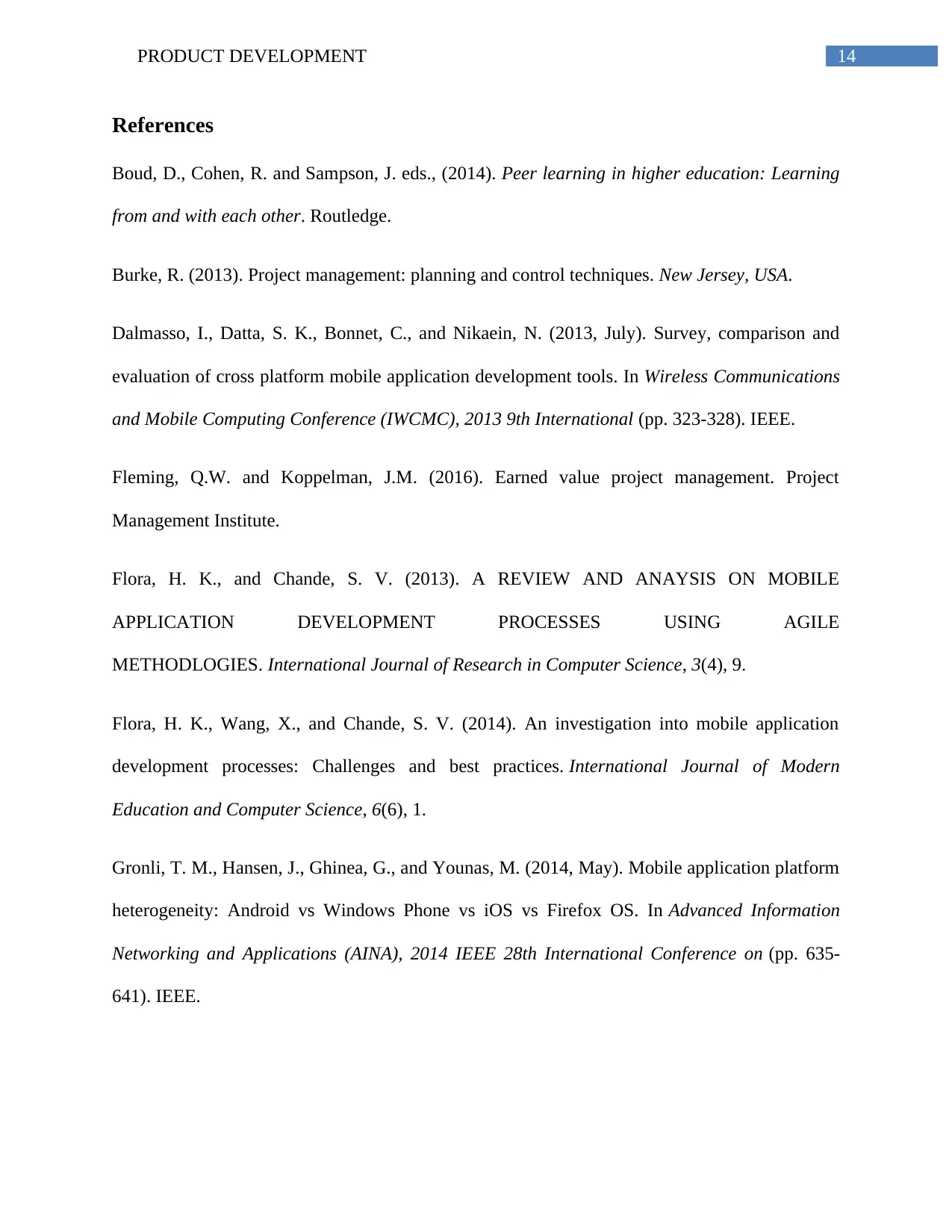
14PRODUCT DEVELOPMENT
References
Boud, D., Cohen, R. and Sampson, J. eds., (2014). Peer learning in higher education: Learning
from and with each other. Routledge.
Burke, R. (2013). Project management: planning and control techniques. New Jersey, USA.
Dalmasso, I., Datta, S. K., Bonnet, C., and Nikaein, N. (2013, July). Survey, comparison and
evaluation of cross platform mobile application development tools. In Wireless Communications
and Mobile Computing Conference (IWCMC), 2013 9th International (pp. 323-328). IEEE.
Fleming, Q.W. and Koppelman, J.M. (2016). Earned value project management. Project
Management Institute.
Flora, H. K., and Chande, S. V. (2013). A REVIEW AND ANAYSIS ON MOBILE
APPLICATION DEVELOPMENT PROCESSES USING AGILE
METHODLOGIES. International Journal of Research in Computer Science, 3(4), 9.
Flora, H. K., Wang, X., and Chande, S. V. (2014). An investigation into mobile application
development processes: Challenges and best practices. International Journal of Modern
Education and Computer Science, 6(6), 1.
Gronli, T. M., Hansen, J., Ghinea, G., and Younas, M. (2014, May). Mobile application platform
heterogeneity: Android vs Windows Phone vs iOS vs Firefox OS. In Advanced Information
Networking and Applications (AINA), 2014 IEEE 28th International Conference on (pp. 635-
641). IEEE.
References
Boud, D., Cohen, R. and Sampson, J. eds., (2014). Peer learning in higher education: Learning
from and with each other. Routledge.
Burke, R. (2013). Project management: planning and control techniques. New Jersey, USA.
Dalmasso, I., Datta, S. K., Bonnet, C., and Nikaein, N. (2013, July). Survey, comparison and
evaluation of cross platform mobile application development tools. In Wireless Communications
and Mobile Computing Conference (IWCMC), 2013 9th International (pp. 323-328). IEEE.
Fleming, Q.W. and Koppelman, J.M. (2016). Earned value project management. Project
Management Institute.
Flora, H. K., and Chande, S. V. (2013). A REVIEW AND ANAYSIS ON MOBILE
APPLICATION DEVELOPMENT PROCESSES USING AGILE
METHODLOGIES. International Journal of Research in Computer Science, 3(4), 9.
Flora, H. K., Wang, X., and Chande, S. V. (2014). An investigation into mobile application
development processes: Challenges and best practices. International Journal of Modern
Education and Computer Science, 6(6), 1.
Gronli, T. M., Hansen, J., Ghinea, G., and Younas, M. (2014, May). Mobile application platform
heterogeneity: Android vs Windows Phone vs iOS vs Firefox OS. In Advanced Information
Networking and Applications (AINA), 2014 IEEE 28th International Conference on (pp. 635-
641). IEEE.
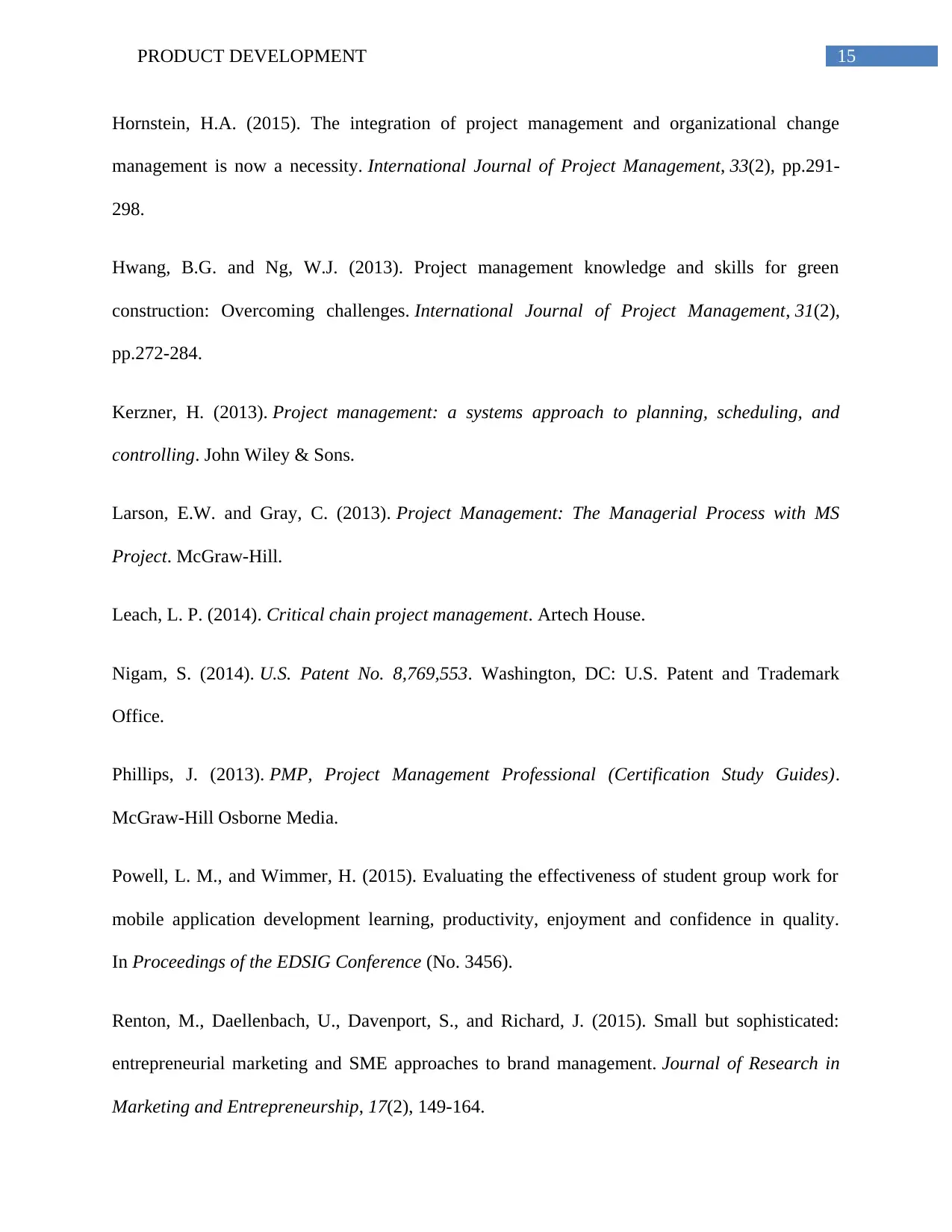
15PRODUCT DEVELOPMENT
Hornstein, H.A. (2015). The integration of project management and organizational change
management is now a necessity. International Journal of Project Management, 33(2), pp.291-
298.
Hwang, B.G. and Ng, W.J. (2013). Project management knowledge and skills for green
construction: Overcoming challenges. International Journal of Project Management, 31(2),
pp.272-284.
Kerzner, H. (2013). Project management: a systems approach to planning, scheduling, and
controlling. John Wiley & Sons.
Larson, E.W. and Gray, C. (2013). Project Management: The Managerial Process with MS
Project. McGraw-Hill.
Leach, L. P. (2014). Critical chain project management. Artech House.
Nigam, S. (2014). U.S. Patent No. 8,769,553. Washington, DC: U.S. Patent and Trademark
Office.
Phillips, J. (2013). PMP, Project Management Professional (Certification Study Guides).
McGraw-Hill Osborne Media.
Powell, L. M., and Wimmer, H. (2015). Evaluating the effectiveness of student group work for
mobile application development learning, productivity, enjoyment and confidence in quality.
In Proceedings of the EDSIG Conference (No. 3456).
Renton, M., Daellenbach, U., Davenport, S., and Richard, J. (2015). Small but sophisticated:
entrepreneurial marketing and SME approaches to brand management. Journal of Research in
Marketing and Entrepreneurship, 17(2), 149-164.
Hornstein, H.A. (2015). The integration of project management and organizational change
management is now a necessity. International Journal of Project Management, 33(2), pp.291-
298.
Hwang, B.G. and Ng, W.J. (2013). Project management knowledge and skills for green
construction: Overcoming challenges. International Journal of Project Management, 31(2),
pp.272-284.
Kerzner, H. (2013). Project management: a systems approach to planning, scheduling, and
controlling. John Wiley & Sons.
Larson, E.W. and Gray, C. (2013). Project Management: The Managerial Process with MS
Project. McGraw-Hill.
Leach, L. P. (2014). Critical chain project management. Artech House.
Nigam, S. (2014). U.S. Patent No. 8,769,553. Washington, DC: U.S. Patent and Trademark
Office.
Phillips, J. (2013). PMP, Project Management Professional (Certification Study Guides).
McGraw-Hill Osborne Media.
Powell, L. M., and Wimmer, H. (2015). Evaluating the effectiveness of student group work for
mobile application development learning, productivity, enjoyment and confidence in quality.
In Proceedings of the EDSIG Conference (No. 3456).
Renton, M., Daellenbach, U., Davenport, S., and Richard, J. (2015). Small but sophisticated:
entrepreneurial marketing and SME approaches to brand management. Journal of Research in
Marketing and Entrepreneurship, 17(2), 149-164.
Secure Best Marks with AI Grader
Need help grading? Try our AI Grader for instant feedback on your assignments.
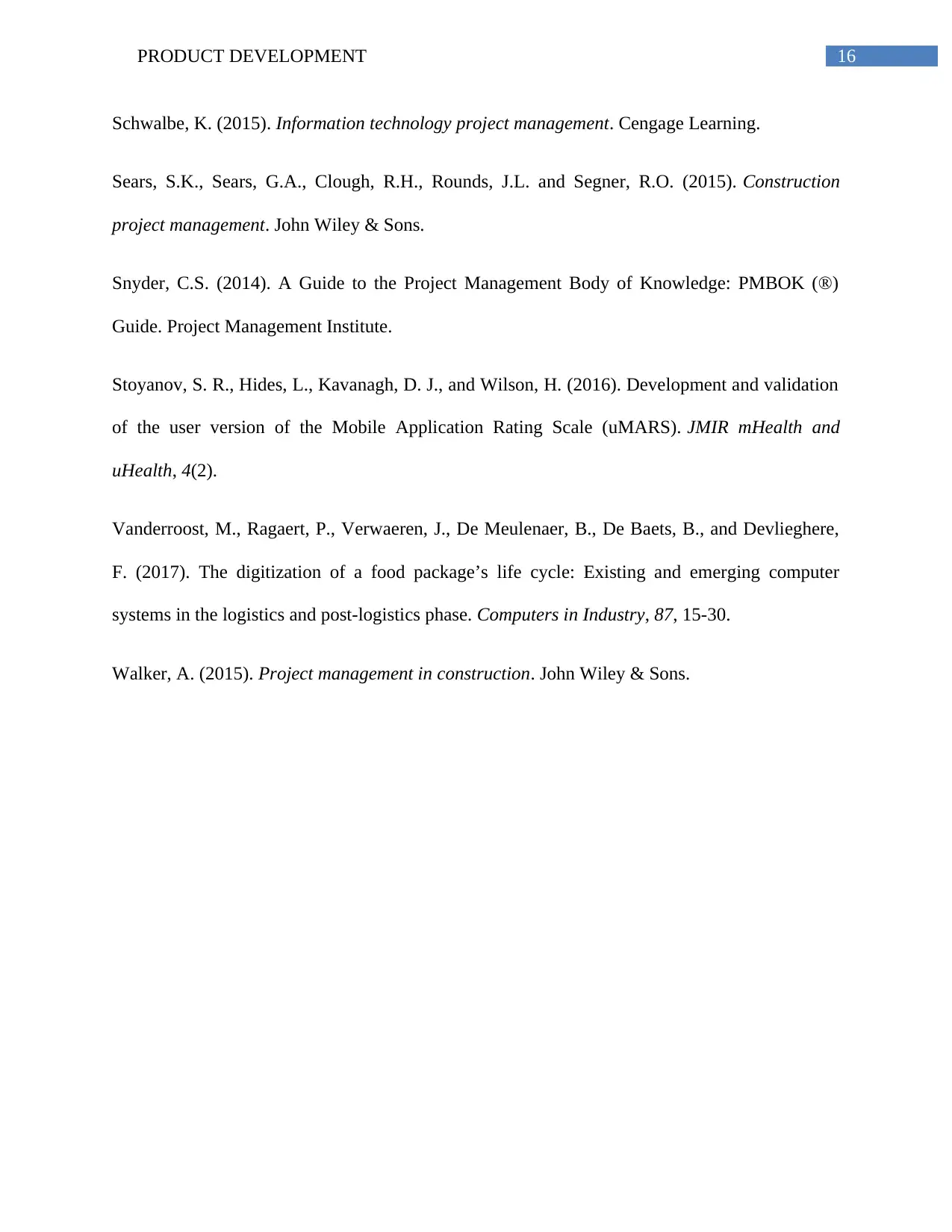
16PRODUCT DEVELOPMENT
Schwalbe, K. (2015). Information technology project management. Cengage Learning.
Sears, S.K., Sears, G.A., Clough, R.H., Rounds, J.L. and Segner, R.O. (2015). Construction
project management. John Wiley & Sons.
Snyder, C.S. (2014). A Guide to the Project Management Body of Knowledge: PMBOK (®)
Guide. Project Management Institute.
Stoyanov, S. R., Hides, L., Kavanagh, D. J., and Wilson, H. (2016). Development and validation
of the user version of the Mobile Application Rating Scale (uMARS). JMIR mHealth and
uHealth, 4(2).
Vanderroost, M., Ragaert, P., Verwaeren, J., De Meulenaer, B., De Baets, B., and Devlieghere,
F. (2017). The digitization of a food package’s life cycle: Existing and emerging computer
systems in the logistics and post-logistics phase. Computers in Industry, 87, 15-30.
Walker, A. (2015). Project management in construction. John Wiley & Sons.
Schwalbe, K. (2015). Information technology project management. Cengage Learning.
Sears, S.K., Sears, G.A., Clough, R.H., Rounds, J.L. and Segner, R.O. (2015). Construction
project management. John Wiley & Sons.
Snyder, C.S. (2014). A Guide to the Project Management Body of Knowledge: PMBOK (®)
Guide. Project Management Institute.
Stoyanov, S. R., Hides, L., Kavanagh, D. J., and Wilson, H. (2016). Development and validation
of the user version of the Mobile Application Rating Scale (uMARS). JMIR mHealth and
uHealth, 4(2).
Vanderroost, M., Ragaert, P., Verwaeren, J., De Meulenaer, B., De Baets, B., and Devlieghere,
F. (2017). The digitization of a food package’s life cycle: Existing and emerging computer
systems in the logistics and post-logistics phase. Computers in Industry, 87, 15-30.
Walker, A. (2015). Project management in construction. John Wiley & Sons.
1 out of 17
Related Documents
Your All-in-One AI-Powered Toolkit for Academic Success.
+13062052269
info@desklib.com
Available 24*7 on WhatsApp / Email
![[object Object]](/_next/static/media/star-bottom.7253800d.svg)
Unlock your academic potential
© 2024 | Zucol Services PVT LTD | All rights reserved.





